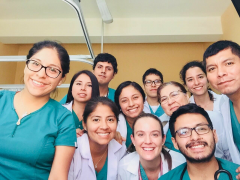Lima, Peru
OB/GYN El Hospital Nacional Docente Madre Niño San Bartolomé
March 18th-May 1st, 2018
For the past six weeks, I have been living in Lima, Peru working at one of their public hospitals for women and children. This experience was made possible because of Weill Cornell Medical College’s relationship and exchange program with The National University of San Marcos. The San Marcos medical students rotate at many of the public hospitals throughout Lima, including the hospital that I worked at, El Hospital Nacional Docente Madre Niño San Bartolomé. During my stay, I did an Obstetrics rotation where I spent three weeks helping to care for patients on the antepartum high-risk ward and three weeks on labor and delivery. As an aspiring Obstetrician and Gynecologist, my primary goal, in addition to improving my Spanish vocabulary and fluency, was to learn about the women’s health and birth practices in another country.
One of the most challenging aspects of my rotation was becoming oriented to my clinical site and learning the Spanish medical vocabulary required to take a patient history and present a patient on rounds. Like in the United States, there are an innumerous number of acronyms that Peruvians use on rounds, which made it difficult to understand rounds for the first week or so. Another immense challenge was utilizing the paper charts are used in Peru (I am now so thankful for the electronic medical record!). To be honest, I spent the first one-two weeks of my rotation trying to learn key vocabulary words and acronyms, understand rounds, and understand how the charts were written and organized.
However, with time, my comprehension improved and I started to be able to decipher the charts better. This enabled me to participate more in rounds and in patient care. I also enjoyed reviewing key topics in high risk Obstetrics and Gynecology in both Spanish and in English, as many of the readings that the physicians in Peru use are written the American College of Obstetrics and Gynecology in English. Throughout the small group learning sessions that the residents partook in, I was sometimes able to be helpful by translating key vocabulary words from English to Spanish. Personally, I found these reviews to be extraordinarily helpful because they allowed me to review key Ob/Gyn topics before starting residency while also allowing me to connect better with my team and better understand my patients.
As I transitioned to the labor and delivery floor, I felt a little more confident and comfortable using my Spanish to talk with patients and the team. Because of this, I was also able to take on a more active role in patient care. My primary role was assisting with fetal monitoring, as the hospital has only two electronic fetal monitors for the entire building, so human manpower serves as the other monitors. Sitting at the bedside with patients to count the number of contractions they had in ten minutes allowed me to get to know patients well and monitor them as they progressed through a normal (or sometimes abnormal) labor course. Furthermore, I was also responsible for monitoring the vitals signs of my patients every 15 minutes to half hour, which helped to make me more proficient at using the sphygmomanometers that I haven’t used since my first or second year of medical school. Finally, and most excitedly, I had the opportunity to follow my patients into the private birthing room once they were ten centimeters dilated. Sometimes, I was even able to assist with the deliveries.
As I established myself as part of the team on the wards, there were things about the Peruvian healthcare system that continued to surprise me when comparing their healthcare system to ours in America. First of all, HIPPA does not exist in Peru and nobody seems concerned about privacy. On a similar note, there are no private rooms and all patients are discussed in front of all the other patients. This was true on both the antepartum service and on labor and delivery, where patients only have the luxury of a private room once they were ten centimeters dilated and through their delivery.
Additionally, I learned that Peruvian women are tough—as the usually go through labor with no pain control and using no pain control during labor is the cultural norm. As I would monitor patients, I would usually hold their hands as their contractions passed and take deep breaths with them. I will never forget the agony on many of their faces, and even though they were in a room full of people, some patients would still cry out in pain. This was challenging to get used to, as I would often want to give something to the patients to alleviate their pain. However, after talking to my residents, I learned that many women in Peru embrace the natural labor process. While this is still challenging for me to accept, I appreciated having the opportunity to see how birth and labor is approached in another healthcare setting and enjoyed learning about the cultural practices and beliefs surrounding labor in another country.
All in all, I had a fabulous time in Peru. I enjoyed learning new Spanish vocabulary, improving my Spanish fluency, meeting doctors and residents from another culture, and getting to know patients as they experienced the life-changing moments of labor and delivery. I am so grateful to the incredible attending physicians and resident physicians who were patient with me as I learned not only how their healthcare and hospital systems functioned but who also helped me to improve my Spanish language skills.


